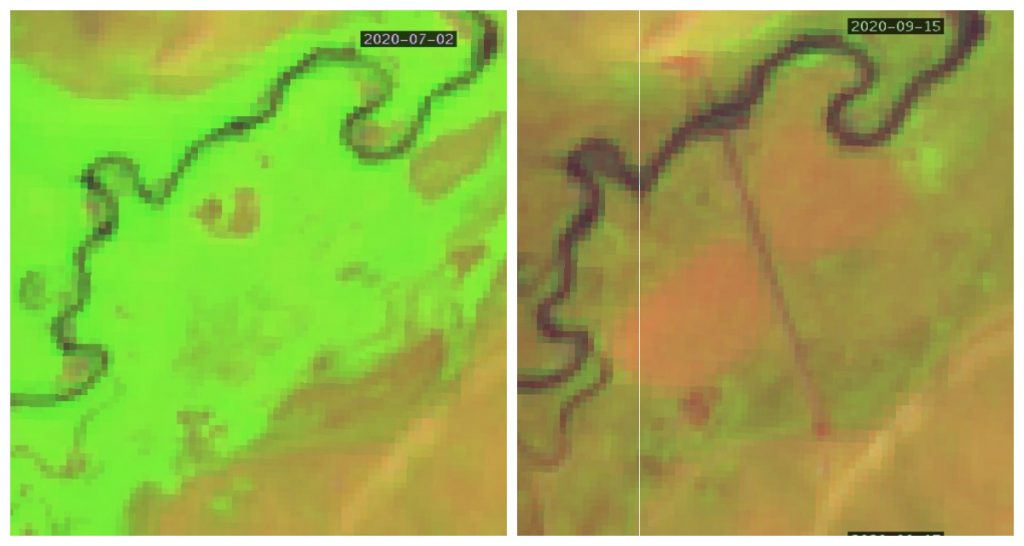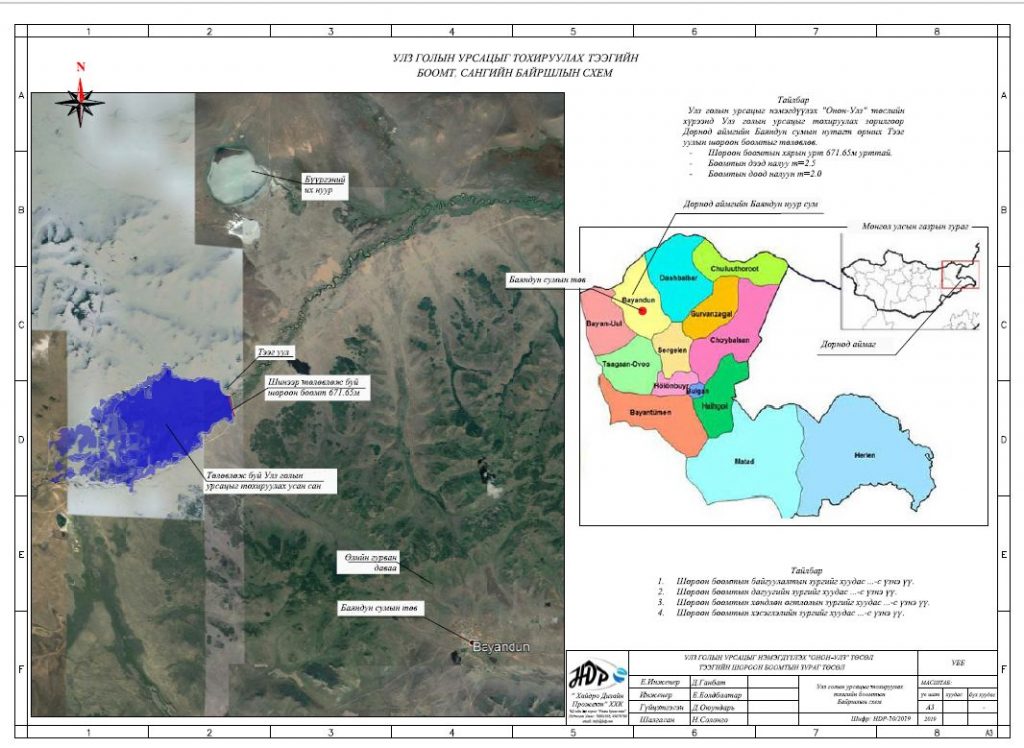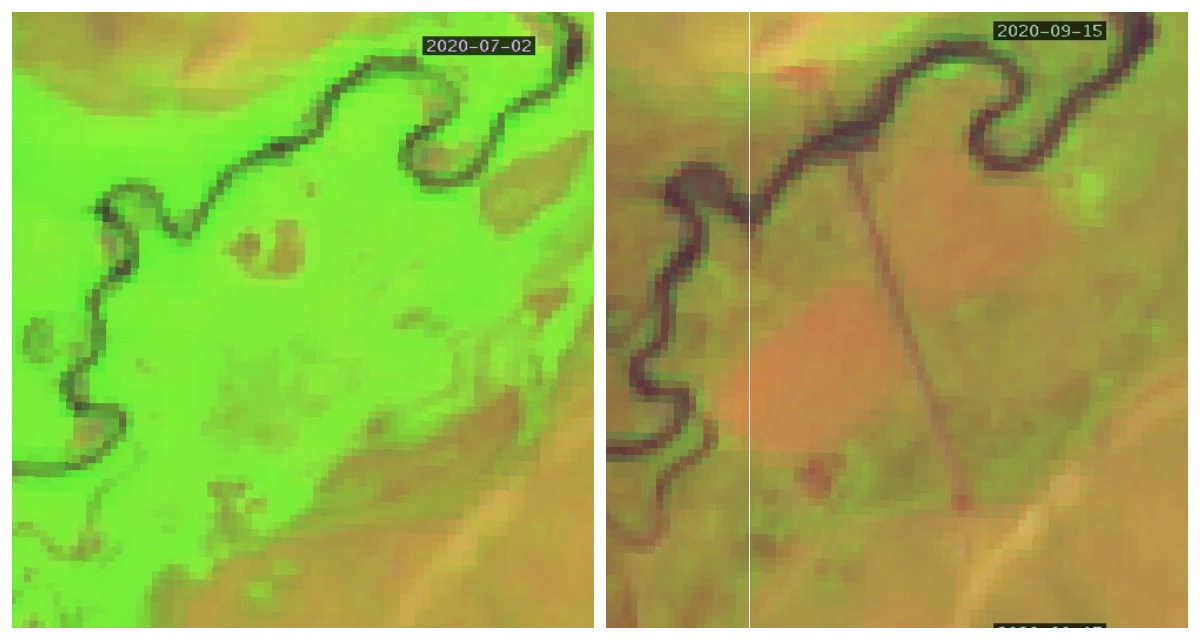
Appeal to Director of UNESCO World Heritage Centre
Dear Ms. Rossler:
Using satellite imagery we established the fact that, in July 2020 Wellmot (Вэлмот) Company started construction of a dam across Ulz River in Dornod Province of Mongolia, the principle source of water for “Landscapes of Dauria” World Heritage property. It was also reported by the official news agency Montsame[1].
To the best of our knowledge, this construction started without prior warning of the adjacent State party of Russia, without proper assessment of potential impacts on the World Heritage property in Mongolia and Russia as well as without due comparison of available alternatives to solve the problem of water scarcity.
In 2019 public documentation for tenders on feasibility study[2] and actual construction[3] was posted in Mongolia on official government web-sites with little time gap between them, which suggests absence of detailed and/or in depth EIA, including a public consultation process on this project. Construction started on July 5 and by September 10 satellite images reflect a 700 meter structure built across floodplain, which is identical in its location and orientation with the dam design shown in tender documents. As of September 10, the Ulz River has not been dammed yet.

https://www.tender.gov.mn
According to the tender documents, the earthen dam, 9-12 meters high and 700 meters long, will block Ulz River 30 kilometers upstream of the World Heritage Property and create a reservoir with a volume of 27 million cubic meters. It is a very large structure for a river with average flow of 7 m3/s. Official justification for the dam is “preventing river from drying” while the name of the project is “Onon-Ulz” which suggests possible further attempt for inter-basin water transfer from the Onon River. Since up to 80% of water consumption in Ulz river basin is attributed to mining, we assume that this construction also is intended to ensure steady water supply to mining enterprises, with expanding irrigated agriculture as the second largest water-consumer (Sukhgerel and Simonov 2019[4]). For reasons unknown this large construction project is not mentioned in the most recent Mongolia Government Action Plan 2020-2024.[5]
Large infrastructure built now will likely have negative impacts on the following natural features of the World Heritage property:
- Water regime of floodplain ecosystem and lacustrine wetlands of the World Heritage property;
- Sediment flow and erosion patterns and habitat conditions in Ulz river;
- Migration of aquatic species and re-colonization of downstream habitats after drought periods, which is an essential part of natural cycle;
- Availability of water in dry periods, since it will evaporate at least 7 million m3 annually from the reservoir surface, which is planned to exceed 10 square kilometers.
- Potential damage to World Heritage wetlands in case of dam collapse and resulting massive flashflood also should be considered, given obvious political nature of the project finance and therefore, likely, substandard dam safety measures.
Creation of this reservoir may also facilitate development of additional mining, ore processing with associated pollution, as well as aquaculture development with introduction of exotic species.

As we reported earlier, in 2017 and 2018 at bilateral talks, the Mongolian side officially informed their Russian counterparts that in order “to protect crane habitat” and the “ecological integrity of the Torey lakes” there is a need to study the feasibility of an interbasin water transfer from the Onon to the Ulz river (Simonov, Kirilyuk, Sukhgerel 2019[6]). Russian scientists expressed concern that an augmentation of the Ulz River flow will lead to unnatural changes in ecosystem dynamics, for example, providing water flow during a dry phase when it should naturally be absent. Mongolian scientists argued that in the increasingly dry conditions endangered cranes and other wildlife may benefit from more water supply if it is artificially secured. No specific plan was presented by the Mongolian side for assessment of potential impacts. In November 2018 the topic was discussed in a meeting of the Mongolian-Russian-Commission on Environmental Cooperation, and the resulting document contains a clear statement: “Both parties take into consideration that maintaining a natural fluctuation of the water regime is a necessary condition to satisfy the criteria which led to UNESCO inscribing the area in the List of World Heritage Sites” (Commission on Environmental Cooperation 2018[7]).
However in April-May 2019 Mongolian Information Agency broadcasted that due to insistence of Parliament Member N. Nomtoibayar the “Onon-Ulz Water Transfer Project” received 2.5 billion tugriks from the state budget and construction should start in 2019 and conclude in 2020 (Montsame, 8 April 2019). On May 2, 2019 the Ministry of Environment issued a tender announcement for assessment of “Blue Horse” water storage and diversion projects on several rivers. This puts Landscapes of Dauria under immediate threat from a water infrastructure project, which has not been subject to any rigorous impact assessment.
If this construction goes unchecked it may subsequently encourage development of reservoirs downstream in areas immediately adjacent to this WH property, as well as elsewhere, such as Egiin Gol Hydro still planned in the headwaters of the Lake Baikal, which is already a subject of multi-year dialogue of the World Heritage Committee and Mongolia.
We call for immediate discontinuation of the construction works and undertaking of comprehensive ESIA with special attention to impacts on the OUVs with public consultations involving all affected parties.
In accordance with § 174 of the Operational Guidelines to the World Heritage Convention (1972) we are submitting to You this new report on the World Heritage property “Landscapes of Dauria”, with a request to verify the information therein, and reflect it, if confirmed, in your considerations and decision-making relating to this property.
Any timely intervention from the UNESCO side, such as a letter to Mongolian and Russian authorities, could help prevent major damage to the “Landscapes of Dauria” World Heritage property resulting from improper management of Ulz river water resources.
Sincerely,
Dugersuren Sukhgerel, Director, Rivers without Boundaries-Mongolia
Eugene Simonov, Doctor of Conservation, Coordinator, Rivers without Boundaries International Coalition
September 22, 2020
[1] https://montsame.mn/en/read/232870
[2] June 24 2019 https://www.tender.gov.mn/mn/invitation/detail/1561080343506
[3] October 16, 2019 https://www.tender.gov.mn/en/invitation/detail/1570643029346#tab_18_3 (Шороон боомтын зураг төсөл.pdf)
[4] https://www.researchgate.net/publication/333564836
[5]http://forum.parliament.mn/projects/10923. Plan in Mongolian. August 2020
[6] www.transrivers.org/pdf/2019HeritageDammedFinal.pdf
[7] (Commission on Environmental Cooperation 2018) Decisions of the 8th Meeting of the Russian-Mongolian Commission on Environmental Protection held in Moscow, November 9-10, 2018 http://www.daurzapoved.com/index.php/en/news-daur/mezhdunarodnoe-sotrudnichestvo/1026-sotrudnichestvo-rossii-i-mongolii-v-sfere-okhrany-prirody-obsudili-v-moskve


